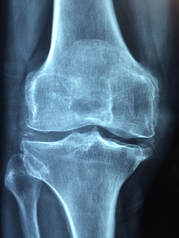Does this Man have Arthritis?Research shows that over 70% of people have arthritic changes, but not all of these people experience symptoms. While the man above likely has arthritic changes that could seen on an X-ray, these changes would be completely normal for his age. More importantly, it does NOT mean he has to be experiencing pain! What is Osteoarthritis?Arthritis is the leading cause of disability in the United States, and osteoarthritis (OA) is the most common form of arthritis. OA is a degeneration (breakdown) of the joint cartilage that can lead to stiffness and decreased range of motion at a joint. It is common in weight-bearing joints including the low back, hips, and knees. What Osteoarthritis is NOT! While the degenerative changes associated with OA do not directly cause pain, they are often blamed as the problem behind the symptoms. In reality, the signs and symptoms of OA are a natural aspect of the aging process. Several studies have been published over the past few years that confirm pain is not related to the natural wear and tear in our tissues. For example, 34% of asymptomatic people >60 years old have been found to have rotator cuff tears (1). Crazy right? One in three people WITHOUT SHOULDER PAIN have a rotator cuff tear. These natural body changes do not occur only in the shoulder, but throughout the entire body. Two out of four people WITHOUT KNEE PAIN have degenerative changes in their knees. (2) Should these people sign up for surgery? I sure hope not. They do not even know there is an issue, and they are doing all of their activities without any problems. There would be no indication for surgery. These people should maintain an active and dynamic lifestyle. Therefore, we cannot confidently say that changes in our tissue are the source of pain or symptoms. Reframing How to Think about OsteoarthritisOA is more closely related to the natural wear and tear that occurs in our joints as we get older. For example, think about your mother, father, grandmother, or grandfather. Over time they have developed wrinkles and other age-related changes. Despite these signs of aging, they do not complain about face pain from the wrinkles or scalp pain from their hair turning from dark to light. The same is also true for our wrinkles on the inside (3). We age on the inside in a similar fashion to how we age on the outside!
Action Steps1) Get active! Have you ever heard the expression "motion is lotion" or "movement is medicine." These catchy sayings are true. One of the best things someone can do for arthritis is movement. At Heafner Health, we recommend a combination of flexibility and strengthening exercises to keep joints strong and mobile. 2) Diet and Weight Management. The Arthritis Foundation reports that "being just 10 pounds overweight puts an extra 30 to 60 pounds of pressure on the knees." (1) A small weight change have a big impact on the stress across your joints. 3) Visit a Doctor of Physical Therapy. Physical therapists are experts in joint mobilizations, movement eduction, exercise prescription, and pain management. Heafner Health Physical Therapy is owned and operated by Dr. Jim Heafner in Boulder, Colorado.References:
1) Sher JS, Uribe JW, Posada A, Murphy BJ, Zlatkin MB. Abnormal findings on magnetic resonance images of asymptomatic shoulders. The Journal of bone and joint surgery. American volume. Jan 1995;77(1):10-15. 2) Bedson J, Croft PR. The discordance between clinical and radiographic knee osteoarthritis: a systematic search and summary of the literature. BMC musculoskeletal disorders. 2008;9:116. 3) Obesity and Arthritis. (2017) Arthritis Foundation. 9, February. 2018. Web access: https://www.arthritis.org/about-arthritis/types/osteoarthritis/articles/obesity-osteoarthritis.php 4) Term "Wrinkles on the Inside" was originally used by Dr. Tim Flynn
7 Comments
|
Heafner HealthPhysical Therapy Archives
April 2024
Categories |



 RSS Feed
RSS Feed
